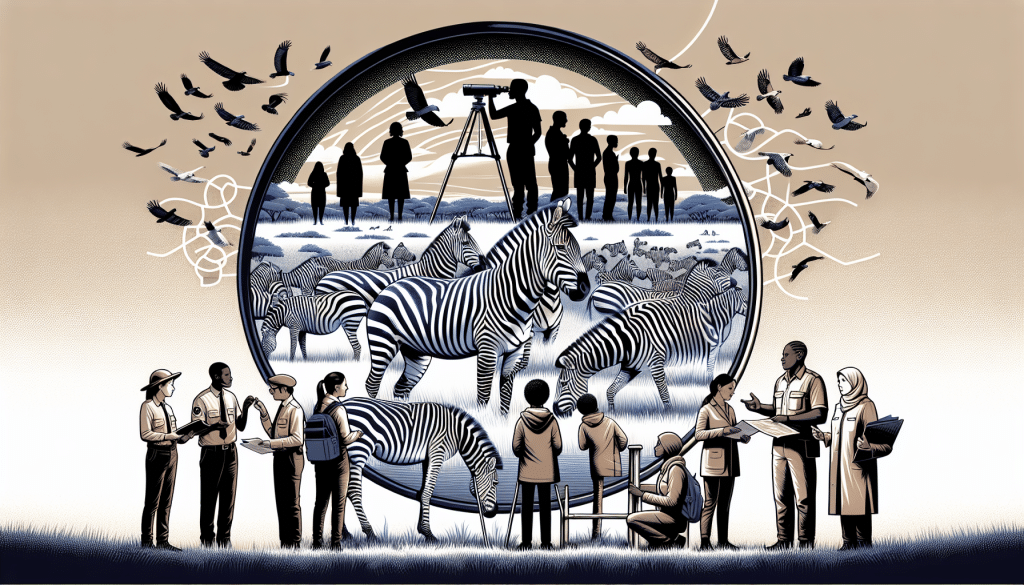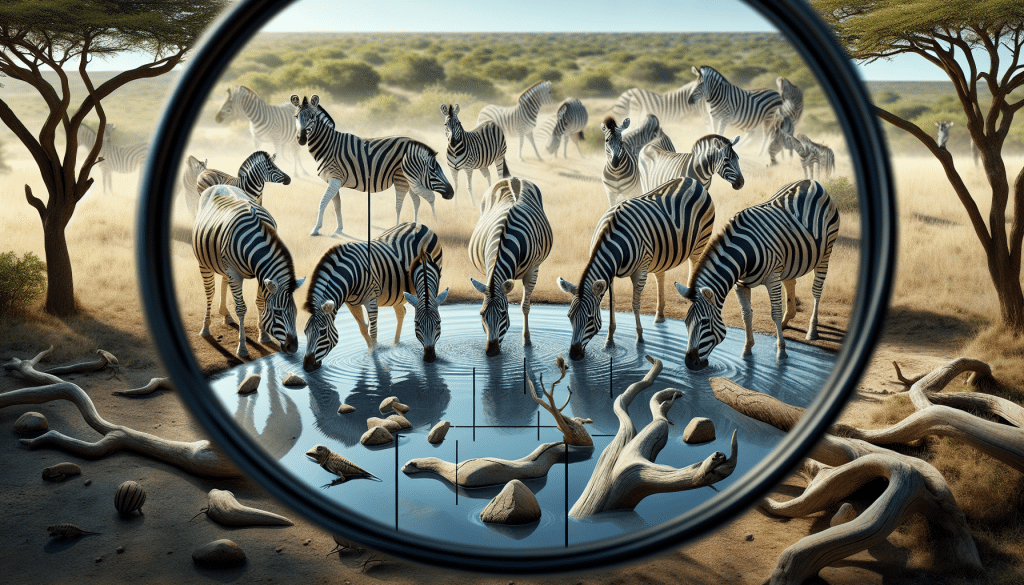Ladies and gentlemen, gather ’round for a wild and wacky adventure into the world of zebra conservation! Prepare yourself for stripes, humor, and a dash of animal activism as we dive into the valiant efforts being made to save these majestic yet slightly confusing creatures. From spreading awareness about zebra fashion trends to setting up a “Save Our Stripes” hotline for confused referees, this article will have you laughing, learning, and itching to join the zebracadabra cause! Get ready to meet some passionate conservationists determined to protect those fabulous black and white stripes. Let’s hop on this quirky safari together and embark on a mission to preserve the zebra population, one laugh-filled step at a time!

Understanding Zebra Populations
Zebras are fascinating creatures with their distinctive black and white stripes. They belong to the Equidae family, which also includes horses and donkeys. There are three main species of zebras: the Plains Zebra (Equus quagga), the Mountain Zebra (Equus zebra), and the Grevy’s Zebra (Equus grevyi). Each species has adapted to different habitats, ranging from grasslands to mountainous regions.
Zebra Species and Their Habitats
Plains Zebras are the most common of the three species and can be found in various habitats across Africa, including savannas, grasslands, and woodlands. Mountain Zebras are primarily found in the mountainous regions of southern Africa, where they navigate rugged terrain with their sturdy hooves. Grevy’s Zebras, on the other hand, inhabit the semi-arid landscapes of eastern Africa, where they have developed the ability to survive on limited water resources.
Current Population Statistics
The population statistics for zebras paint a concerning picture. According to recent surveys, the population of Plains Zebras is estimated to be around 500,000 individuals, while Mountain Zebras and Grevy’s Zebras face a more critical situation with only 9,000 and 2,500 individuals, respectively. These numbers highlight the urgent need for conservation efforts to ensure the survival of these magnificent creatures.
Factors Affecting Zebra Populations
Various factors contribute to the decline in zebra populations. Habitat destruction and fragmentation pose a significant threat as human activities, such as agriculture and urban development, encroach upon their natural habitats. Additionally, poaching for zebra skins, which are highly valued in the illegal trade market, further endangers their populations. Competition with livestock resources and the ever-increasing effects of climate change on their fragile habitats also play a role in the declining zebra populations.
Threats to Zebra Conservation
To better understand the challenges faced by zebra conservationists, it is crucial to delve into the specific threats faced by these charismatic animals.
Habitat Destruction and Fragmentation
With expanding human populations and the need for agricultural land, vast areas of zebra habitats have been destroyed, leading to fragmentation of their ranges. This fragmentation isolates zebra populations, making them more vulnerable to genetic deterioration and limiting their ability to access resources necessary for their survival.
Poaching and Illegal Trade of Zebra Skins
Zebra skins hold significant cultural and commercial value, driving illegal trade and poaching. The demand for these skins, often used for traditional clothing and accessories, puts zebras at risk. Poachers target these animals, creating a severe imbalance in zebra populations.
Competition with Livestock and Human Encroachment
As humans expand into zebra habitats with their livestock, competition for resources intensifies. Zebras must compete for grazing areas and water sources, putting additional strain on their populations. The encroachment of human settlements further threatens their survival, interrupting their natural behaviors and displacing individuals from their traditional habitats.
Climate Change and Its Impact on Zebra Habitats
Climate change poses a significant threat to zebra populations as it alters their habitats and disrupts their natural patterns. Changing rainfall patterns, prolonged droughts, and shifts in vegetation distribution challenge zebras’ ability to find sufficient food and water. These challenges exacerbate pressures on their populations, making it increasingly difficult for them to adapt to changing environments.

Zebra Conservation Laws and Policies
Conservation laws and policies play a critical role in safeguarding zebra populations, both nationally and internationally.
International Legislation Protecting Zebras
Numerous international agreements, such as the Convention on International Trade in Endangered Species of Wild Fauna and Flora (CITES), protect zebras and regulate their trade. CITES enforces strict regulations on the trade of zebra products, ensuring their legal status and discouraging poaching.
Regional Conservation Policies
At the regional level, many countries have implemented programs to protect zebras and their habitats. These policies aim to preserve viable populations, promote sustainable management of resources, and mitigate threats such as habitat destruction and poaching.
Enforcement of Anti-Poaching Laws
Effective enforcement of anti-poaching laws is crucial for the conservation of zebras. Governments and conservation organizations work together to strengthen anti-poaching efforts through increased patrols, intelligence gathering, and collaboration with local communities. The presence of well-trained rangers and wildlife law enforcement units is essential to combat poaching effectively.
Trade Regulations and CITES
Controlling the trade of zebra products is a vital aspect of conservation efforts. Regulatory bodies collaborate with CITES to regulate the legal trade of zebra skins and other products. Strict monitoring and regulation help combat illegal trade and reduce the demand for these items.
Conservation Organizations and Their Roles
Numerous organizations, both governmental and non-governmental, actively work towards zebra conservation.
Non-Governmental Organizations (NGOs) in Zebra Conservation
NGOs play a crucial role in preserving zebra populations by initiating conservation projects, conducting research, and raising awareness. These organizations work on multiple fronts, including habitat restoration, community engagement, and education programs to promote understanding and appreciation for zebras.
Collaborative Efforts Between Organizations
Collaboration between conservation organizations is essential for effective zebra conservation. Cooperative efforts allow for resource and knowledge sharing, ultimately fostering better outcomes and maximizing the impact of conservation initiatives.
Animal Welfare Groups and Advocacy
Animal welfare groups focus on ensuring the protection and well-being of individual zebras. These organizations advocate for policies that prioritize the humane treatment and ethical considerations for zebras and other wildlife.
Community Involvement and Indigenous Peoples
Engaging local communities and indigenous peoples in zebra conservation initiatives is vital for long-term success. By involving communities in decision-making processes, actively promoting sustainable livelihoods, and educating them about the importance of zebras, conservation efforts can gain strength and support from the very people who share their habitats with these remarkable creatures.

Protected Areas and Reserves
Establishing protected areas and reserves dedicated to zebra conservation is fundamental to their survival.
Establishment of Zebra Sanctuaries
Creating dedicated zebra sanctuaries ensures the provision of suitable habitats and reduces external threats. These sanctuaries act as safe havens for zebras, allowing them to flourish without direct competition from human activities.
Management of National Parks and Reserves
National parks and reserves that encompass zebra habitats play a significant role in their conservation. Effective management practices, including regular monitoring, habitat restoration, and anti-poaching measures, help protect zebras and their ecosystems.
Corridors and Wildlife Migration
Preserving migration corridors allows zebras to navigate their habitats and access essential resources. These corridors connect various habitats and enable the migration of not only zebras but also other wildlife, promoting biodiversity conservation.
Impact and Success Stories of Protected Areas
Protected areas and reserves have shown promising results in zebra conservation. Positive outcomes include steady population growth, habitat restoration, and reduced instances of illegal activities such as poaching. These success stories serve as inspiration for ongoing and future conservation efforts.
Science and Research in Zebra Conservation
Science and research provide vital insights into zebra behavior, ecology, and the impact of conservation efforts.
Population Monitoring Techniques
Scientific monitoring techniques, such as camera traps and aerial surveys, allow researchers to assess zebra populations and track their movements. Data collected through these methods help identify population trends, distribution patterns, and potential threats, aiding in the implementation of targeted conservation strategies.
Genetic Studies for Biodiversity
Genetic studies contribute to zebra conservation by assessing genetic diversity within populations, identifying specific subspecies, and studying genetic adaptations to different habitats. This information helps develop effective breeding programs and conservation strategies to maintain healthy and genetically robust zebra populations.
Behavioral Research and Ecology
Understanding zebra behavior and their interactions with their environment is crucial for their conservation. Behavioral research provides insights into their feeding patterns, social structures, and movement patterns, helping conservationists design strategies that ensure the well-being and sustainable management of zebra populations.
Technology and Conservation Tools
Technological advancements, such as satellite tracking and bioacoustic monitoring systems, offer valuable tools for zebra conservation. These innovations enable researchers to gather data remotely, track zebra movements, and identify crucial habitats, contributing to evidence-based conservation strategies.
Conservation Education and Public Awareness
Raising public awareness and educating communities are essential components of successful zebra conservation initiatives.
Educational Programs in Local Communities
Implementing educational programs in local communities helps cultivate awareness and understanding of the importance of zebras and their ecosystems. These programs aim to foster a sense of stewardship among community members, encouraging them to actively participate in conservation efforts.
Global Campaigns and the Role of Media
Global campaigns and the involvement of media outlets help raise awareness about the plight of zebras and the need for conservation. By highlighting success stories, sharing informative content, and promoting responsible tourism, these campaigns can reach a broader audience and inspire action.
Tourism and Its Influence on Conservation Efforts
Tourism can play a significant role in zebra conservation when managed responsibly. Well-regulated and sustainable tourism practices provide funding for conservation projects, contribute to local economies, and create incentives for protecting zebra habitats.
Conservation Messaging and Social Media
Leveraging social media platforms and digital communication channels allows conservation organizations to engage with a broader audience. By sharing conservation messaging, successes, and challenges, these platforms amplify the voices of zebra conservationists, inviting the public to join the cause and make a positive impact.
Funding Zebra Conservation Initiatives
Conservation initiatives require significant financial resources to be effective.
Sources of Funding for Conservation Projects
Funding for zebra conservation comes from various sources, including government grants, private donations, corporate sponsorships, and philanthropic organizations. Diversifying funding sources ensures the sustained implementation of conservation projects and enables organizations to respond to emerging challenges effectively.
Grants and Philanthropy in Wildlife Conservation
Grants provided by governmental, non-governmental, and philanthropic entities support zebra conservation initiatives worldwide. These grants fund research, conservation programs, capacity-building activities, and community engagement efforts, ultimately contributing to the overall success of zebra conservation.
Financial Challenges and Budget Allocation
Conservation organizations often face logistical and financial challenges. Budget allocation is essential to prioritize conservation efforts, invest in personnel, research, education, and anti-poaching measures, and ensure that resources are directed towards the most crucial aspects of zebra conservation.
The Role of Zoos and Conservation Breeding Programs
Zoos and conservation breeding programs play a vital role in zebra conservation. These institutions provide a safe environment for breeding and raising zebras, allowing for the preservation and reintroduction of threatened or endangered species. Additionally, zoos serve as educational platforms, raising awareness about the importance of wildlife conservation.
Community-Based Conservation Approaches
Incorporating the perspectives and needs of local communities is essential for sustainable zebra conservation.
Local Community Engagement Strategies
Engaging with local communities through participatory processes and involving them in decision-making can foster a sense of ownership and responsibility towards zebra conservation. Programs that offer sustainable income opportunities, training, and alternative livelihood options help build trust and strengthen the commitment to conservation.
Benefits to Local Economies through Conservation
Conservation initiatives can have positive impacts on local economies. By establishing eco-tourism ventures and providing employment opportunities within the context of zebra conservation, communities can benefit financially while embracing their role as stewards of natural resources.
Conflict Resolution Between Humans and Zebras
Conflicts between humans and zebras can arise due to resource competition, crop damage, or perceived threats. Implementing conflict resolution strategies, such as employing deterrent methods, introducing sustainable farming practices, and establishing compensation programs for affected individuals, helps mitigate these conflicts and ensure peaceful coexistence.
Sustainable Livelihoods and Alternative Income Sources
Promoting sustainable livelihoods and alternative income sources encourages communities to move away from activities that harm zebra populations. By supporting ecologically-friendly practices, developing local enterprises, and facilitating access to markets for sustainable products, communities can reduce their reliance on zebra habitats for income generation.
Challenges and Future of Zebra Conservation
While significant progress has been made in zebra conservation, several challenges and future considerations remain.
Adapting to Changing Environments
As climate change continues to alter zebra habitats, conservation strategies must adapt accordingly. By promoting resilience and ensuring natural habitats can withstand the impacts of climate change, zebra populations have a better chance of survival in the face of environmental uncertainty.
Balancing Conservation with Socioeconomic Needs
Finding a balance between zebra conservation and socioeconomic needs is essential. Conservation efforts must take into account the needs of local communities, their cultural values, and their livelihoods. Sustainable development approaches that prioritize the well-being of both people and zebras are crucial for long-term success.
The Role of International Cooperation
International cooperation is vital for zebra conservation, as zebras cross political borders, requiring collaborative efforts from neighboring countries. Sharing information, resources, and expertise helps create a united front against threats faced by zebras and fosters regional conservation initiatives.
Predictions and Goals for Future Conservation Work
The future of zebra conservation lies in continued collaboration, innovation, and dedication. Conservationists strive to stabilize zebra populations, restore their habitats, eliminate poaching, and engage communities in meaningful ways. By setting clear goals, investing in research, and implementing comprehensive conservation strategies, we can ensure a future where zebras can roam freely and harness their unique black and white stripes for generations to come.
In conclusion, zebra conservation efforts are paramount in ensuring the survival of these captivating creatures. By addressing threats such as habitat destruction, poaching, competition with livestock, and climate change, while simultaneously promoting education, community involvement, and sustainable practices, we can secure a vibrant future for zebras. With dedication, collaboration, and a touch of humor, we can save the stripes and preserve the wonder of these remarkable animals for generations to come.



